Building in the Caribbean is unlike construction anywhere else. The region’s unique climate change challenges, breathtaking landscapes, and cultural heritage demand thoughtful planning and innovative techniques. Whether you’re working on a luxury beachfront property or a resilient community structure, Caribbean construction combines creativity with practicality to meet these distinct challenges.
You’ll need to consider factors like hurricane resistance, sustainable materials, and local architectural styles. The tropical environment requires designs that not only look stunning but also withstand the elements. From sourcing materials to navigating regional regulations, every step plays a crucial role in creating structures that endure.
Caribbean construction is more than just building—it’s about preserving the region’s beauty while addressing its environmental and social needs. By blending modern technology with traditional craftsmanship, you can create spaces that honor the Caribbean spirit and stand the test of time.
Caribbean Construction Challenges and Solutions
Construction in the Caribbean faces unique challenges due to the region’s geographical and climatic conditions. Addressing these complexities requires targeted strategies and advanced methods.
Overview of the Caribbean Construction Industry
The Caribbean construction industry reflects the region’s diverse environments, spanning coastal zones, mountains, and urban hubs. Your projects must adapt to challenges like high humidity, saline conditions, and frequent tropical storms. The demand for hurricane-resistant structures is driving innovation in materials and designs. Local architectural styles, which often prioritize open layouts and natural ventilation, influence your approach to building in the Caribbean.
Economic dependencies on tourism and exports create fluctuations in construction demand. Additionally, shipping delays and material costs increase the difficulty of maintaining budgets and timelines. To counter these issues, you should consider partnerships with local suppliers and contractors to reduce logistical constraints. Leveraging skilled local labor also strengthens community ties and ensures cultural relevance.
Importance of Sustainable and Resilient Building Practices
Sustainable construction practices are essential to combat climate-related risks and preserve the Caribbean’s ecosystem. Incorporating renewable energy solutions, like solar panels and wind turbines, into construction designs aligns structures with the region’s environmental goals. You should also integrate rainwater harvesting systems to counter water scarcity and flooding.
Resilient architecture enhances building longevity amid hurricanes and earthquakes. Selecting materials resistant to corrosion and degradation, such as reinforced concrete and treated timber, ensures structural stability. Sustainable designs that factor in energy efficiency, natural ventilation, and reduced carbon footprints drive the region’s commitment to environmental stewardship.
Key Stakeholders: Developers, Investors, and Regulators
Developers, investors, and regulators shape the course of construction in the Caribbean by ensuring projects meet regulatory, financial, and environmental standards. You, as a developer, must navigate policies addressing land use, zoning, and environmental permits for compliance. Valuable insights from regulators guide sustainable planning, addressing risks tied to vulnerable ecosystems.
Investors play a crucial role in financing projects that blend sustainability with profitability. High demand for eco-friendly tourism resorts and green residential developments draws attention from global investors. For achieving mutual goals, you should emphasize project transparency, aligning your plans with market demands and long-term value.
Regulatory bodies enforce standards that mitigate the impact of construction challenges. For example, hurricane codes dictate structural features like impact-resistant windows and roof tie-downs. Strong collaboration with regulatory agencies ensures you adhere to local laws while promoting innovation in construction.
Climate Change Considerations
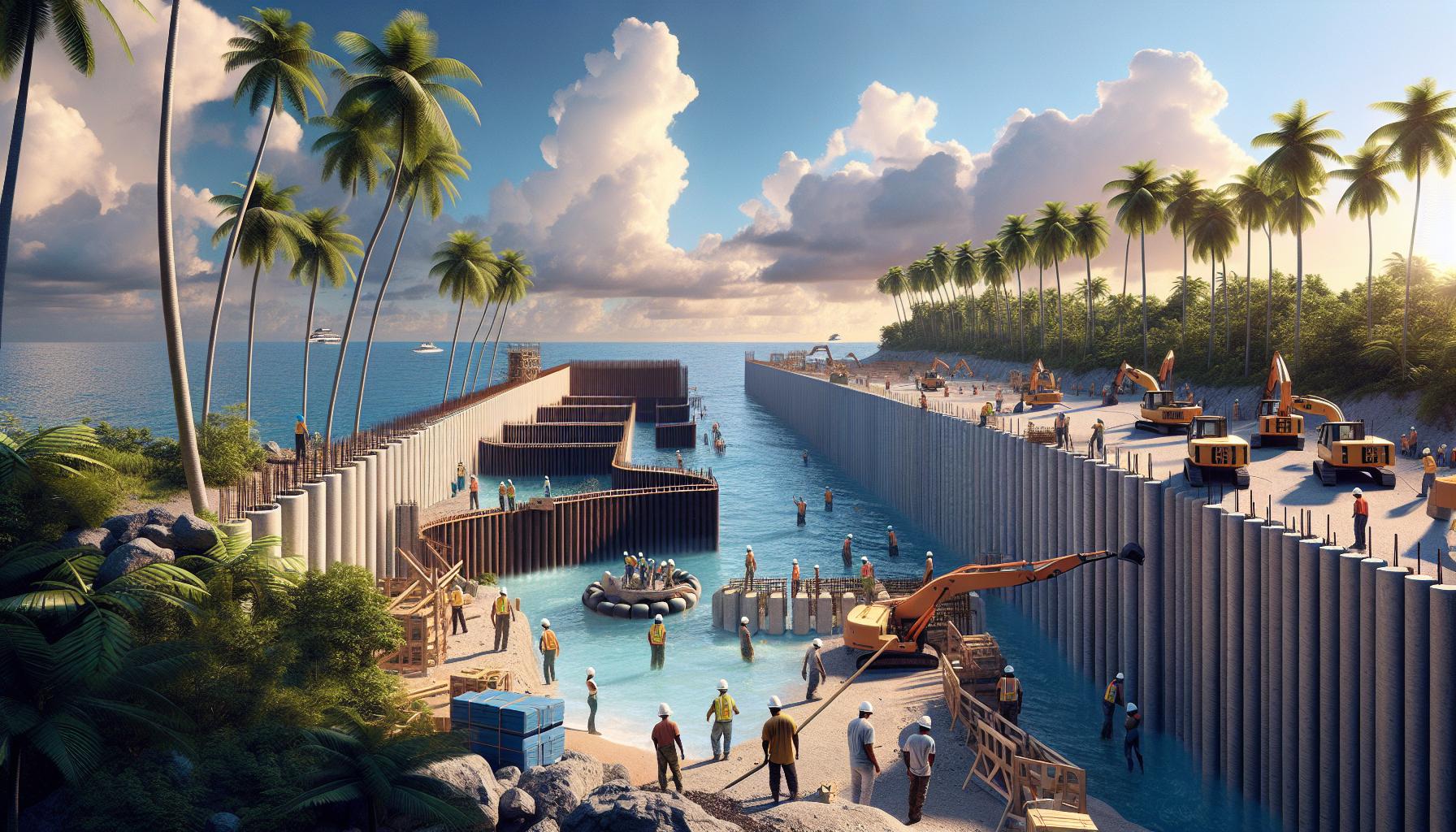
Addressing climate change is crucial for building in the Caribbean due to the region’s vulnerability to environmental shifts and extreme weather patterns. Construction strategies that focus on resilience and sustainability mitigate risks and ensure long-term viability.
Adapting to Rising Sea Levels and Extreme Weather Events
Rising sea levels and frequent storms pose significant construction challenges. When building in the Caribbean, incorporating elevated foundations, reinforced seawalls, and effective drainage systems reduces flood risks. Coastal developments benefit from site analysis to assess erosion susceptibility and water encroachment risks. For example, materials resistant to water damage, like treated concrete and flood-proof barriers, enhance durability in flood-prone areas.
Hurricane-resilient designs, including aerodynamic roofs and reinforced exteriors, ensure structural stability during storms. Retrofitting older structures with modern resistance measures is necessary to align with current climate demands. Strategies like these promote sustainable construction practices, protecting buildings and residents alike from worsening climatic impacts.
Incorporating Resilient Design and Materials
Using resilient designs and materials addresses construction challenges posed by the Caribbean’s climate. Structures designed to withstand high winds and heavy rains, such as those with reinforced concrete frames, exhibit greater longevity. Sustainable construction practices also involve incorporating green roofs, solar energy systems, and shading devices to reduce environmental strain.
Materials withstand climate conditions when they resist corrosion, moisture, and salt-related degradation. Saline-heavy air requires using non-corrosive reinforcements, like stainless steel and protective coatings, to maintain structural integrity. While upfront investment in resilient materials may be higher, their extended lifespan minimizes repair and replacement costs.
Impact of Climate Change on Construction Costs and Timelines
Climate change impacts construction in the Caribbean by escalating costs and prolonging timelines. Challenges like extreme weather delays, labor shortages, and material supply disruptions increase expenses. For example, post-storm recovery often drives up material prices due to heightened demand.
Mitigating these effects involves forecasting weather patterns during project planning and sourcing materials locally to reduce import delays. Sustainable construction practices, such as prefabrication and modular building techniques, also shorten project schedules despite climate-imposed interruptions. Proactive financial planning and innovative methods help safeguard projects from unforeseen climate-related disruptions.
Regulatory Hurdles
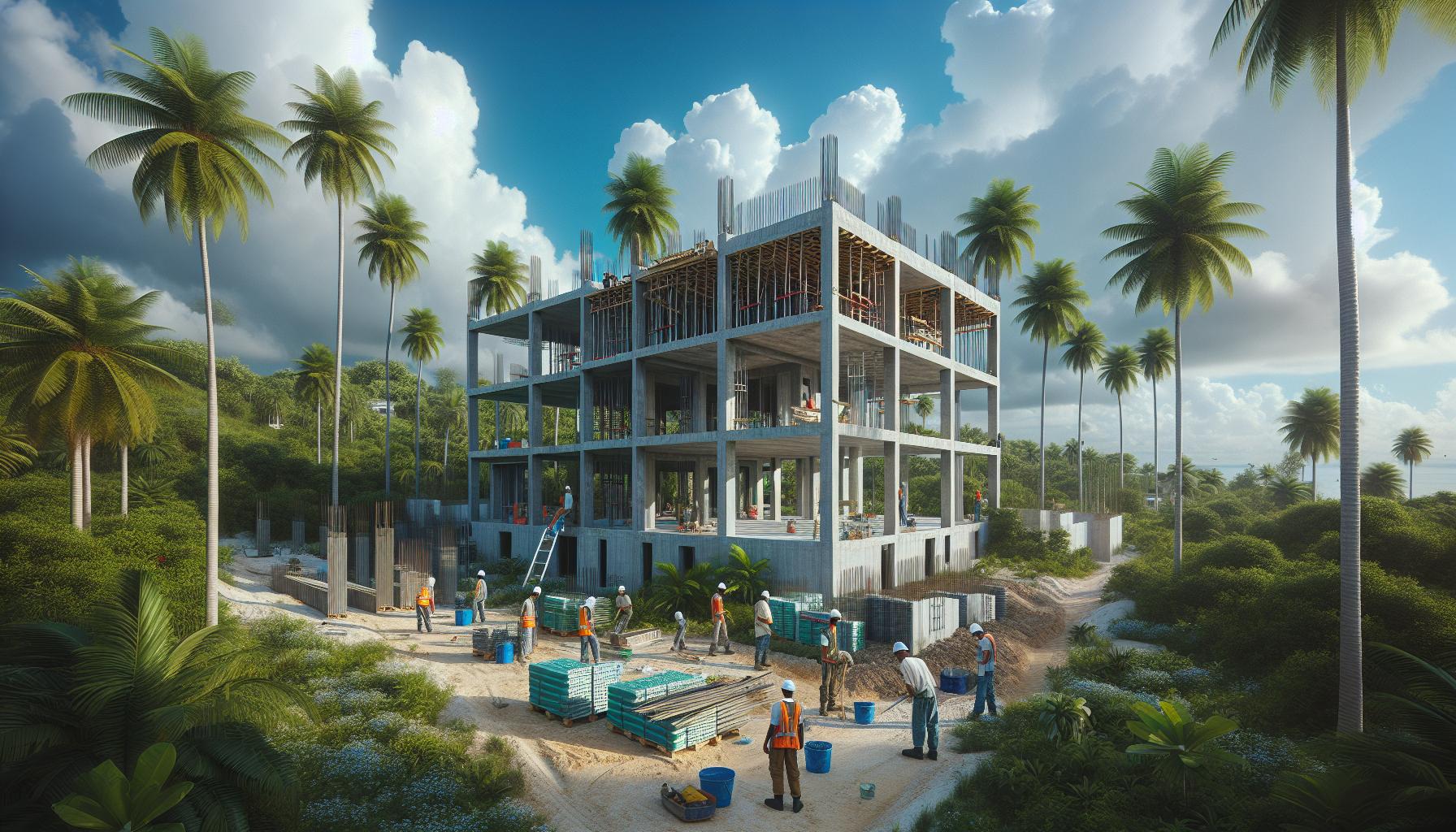
Understanding and overcoming regulatory hurdles is critical to successfully building in the Caribbean. These challenges often stem from navigating complex building codes, adapting to regional variations, and streamlining approval processes for construction projects.
Navigating Building Codes and Zoning Regulations
Building in the Caribbean requires compliance with strict building codes and zoning regulations designed to address climate resilience and environmental priorities. These include hurricane-resistant design mandates, elevated foundation requirements, and sustainable construction standards. For instance, local governments often enforce zoning laws to avoid structures being built in high-risk flood zones or ecologically sensitive areas.
Regulatory frameworks frequently encompass specific material usage, energy-efficiency goals, and drainage considerations to mitigate extreme weather impacts. Failing to adhere to these codes can delay projects or lead to costly redesigns. Collaborating with local regulatory authorities early in the planning phase helps align your project with these standards and reduces risks of non-compliance.
Regional Variations in Regulatory Requirements
Caribbean nations each enforce unique regulatory requirements, reflecting their individual environmental challenges and priorities. For example, the Bahamas often focuses on flood-resistant designs, while countries like Dominica emphasize earthquake resilience due to seismic activity. Developers may also face diversity in permit durations, fee structures, and environmental clearances.
You must adapt to these regional differences by understanding localized construction challenges and engaging with local expertise. Employing consultants knowledgeable about specific island regulations ensures that your construction project remains streamlined and compliant across various regions.
Strategies for Streamlining the Approval Process
Streamlining regulatory approval processes can significantly reduce project timelines and costs. Submitting detailed plans with pre-approved sustainable construction practices often speeds up permitting. Incorporating renewable energy systems, non-corrosive materials, and efficient drainage solutions demonstrates alignment with local goals and fosters quicker approvals.
Forming partnerships with national development boards and hiring local professionals with established relationships with regulators facilitates smoother application processing. Regular communication with authorities ensures clarity and resolves potential roadblocks promptly. Proactive planning and thorough documentation are critical to avoiding delays and ensuring timely completion of construction projects in the Caribbean.
Technological Changes in Construction
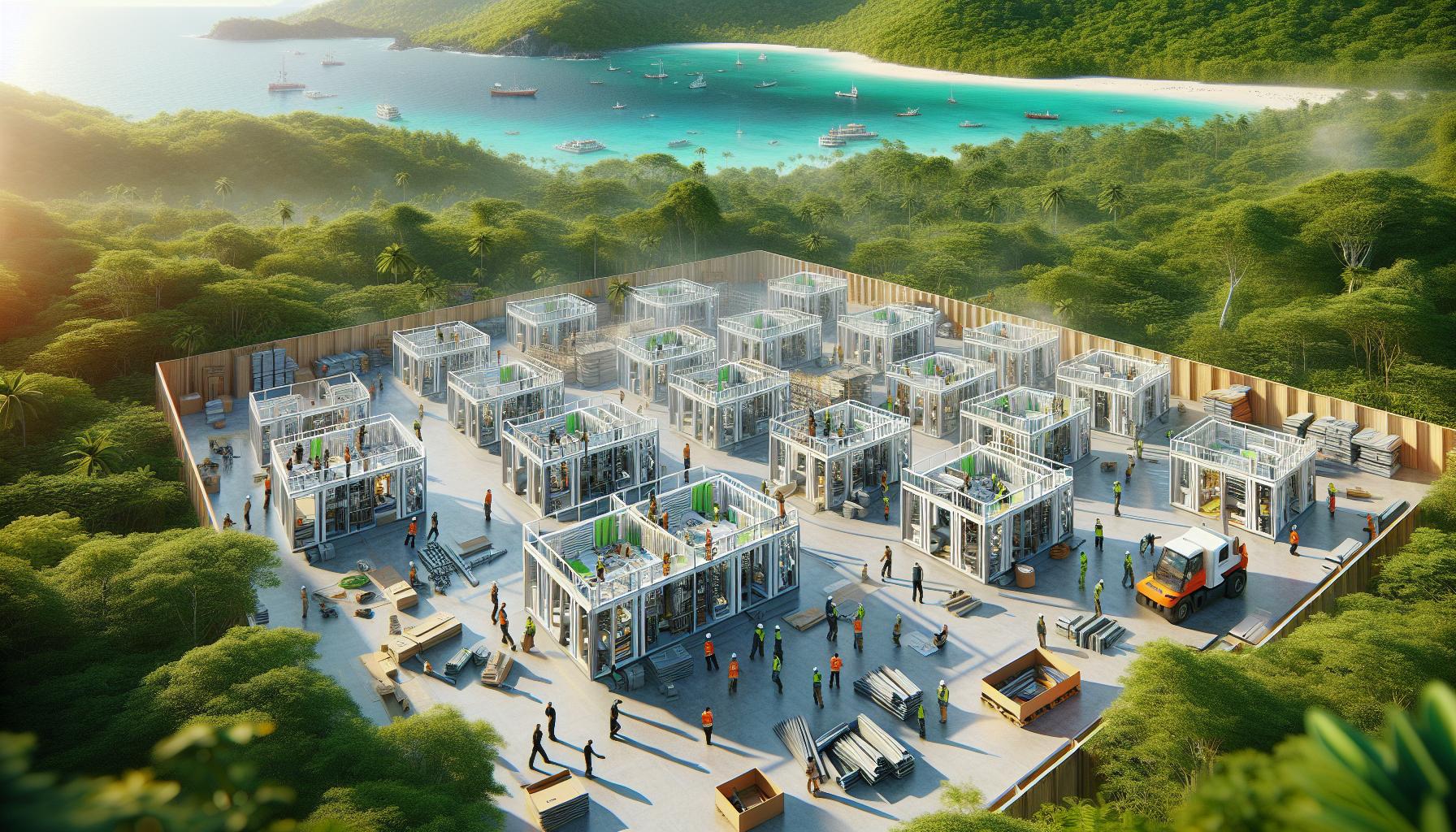
Technological advancements are transforming construction in the Caribbean, addressing regional challenges like climate resilience, sustainability, and resource efficiency. Innovations are enhancing building longevity and improving project execution amidst environmental and regulatory complexities.
Adoption of Green Technologies and Smart Building Solutions
Green technologies and smart systems are increasingly integral to sustainable construction practices in the region. Solar panels and energy-efficient HVAC systems provide renewable energy solutions critical for reducing operating costs and environmental impact. For example, adopting solar water heaters or LED lighting promotes eco-friendly development while aligning with sustainability goals.
Smart building solutions, including IoT-enabled sensors and automated systems, improve resource management. These technologies monitor energy usage, detect structural vulnerabilities, and optimize maintenance schedules, essential in addressing construction challenges like high humidity and storm damage. Implementing these tools reduces operational inefficiencies while ensuring compliance with environmental standards.
Role of Prefabrication and Modular Construction in the Caribbean
Prefabrication and modular designs streamline construction in the Caribbean, reducing labor costs and project timelines. Off-site construction minimizes weather disruptions and produces components like wall panels and trusses that withstand tropical conditions. Prefabricated concrete systems enhance durability, a critical consideration during hurricanes.
Modular methods support sustainable construction practices by cutting material waste and limiting site disturbances. For instance, modular homes designed for elevated foundations and reinforced with non-corrosive materials address climate risks while adhering to building codes. These strategies are invaluable for ensuring affordability and resilience throughout the region.
Opportunities for Innovation in Construction Practices
Innovation opportunities focus on enhancing resilience against climate-related risks and optimizing project efficiency. Advanced materials like self-healing concrete and corrosion-resistant alloys combat environmental stressors like saline conditions. Drone technology and 3D mapping simplify site assessments, improving planning accuracy in diverse terrains.
Digital tools like Building Information Modeling (BIM) enhance coordination among stakeholders, reducing delays while ensuring adherence to sustainable construction practices. Adaptive designs that incorporate energy-efficient facades or rainwater harvesting systems balance resilience with eco-conscious solutions. Embracing these innovations addresses construction challenges and supports long-term objectives for building in the Caribbean.
Sustainable Construction Practices
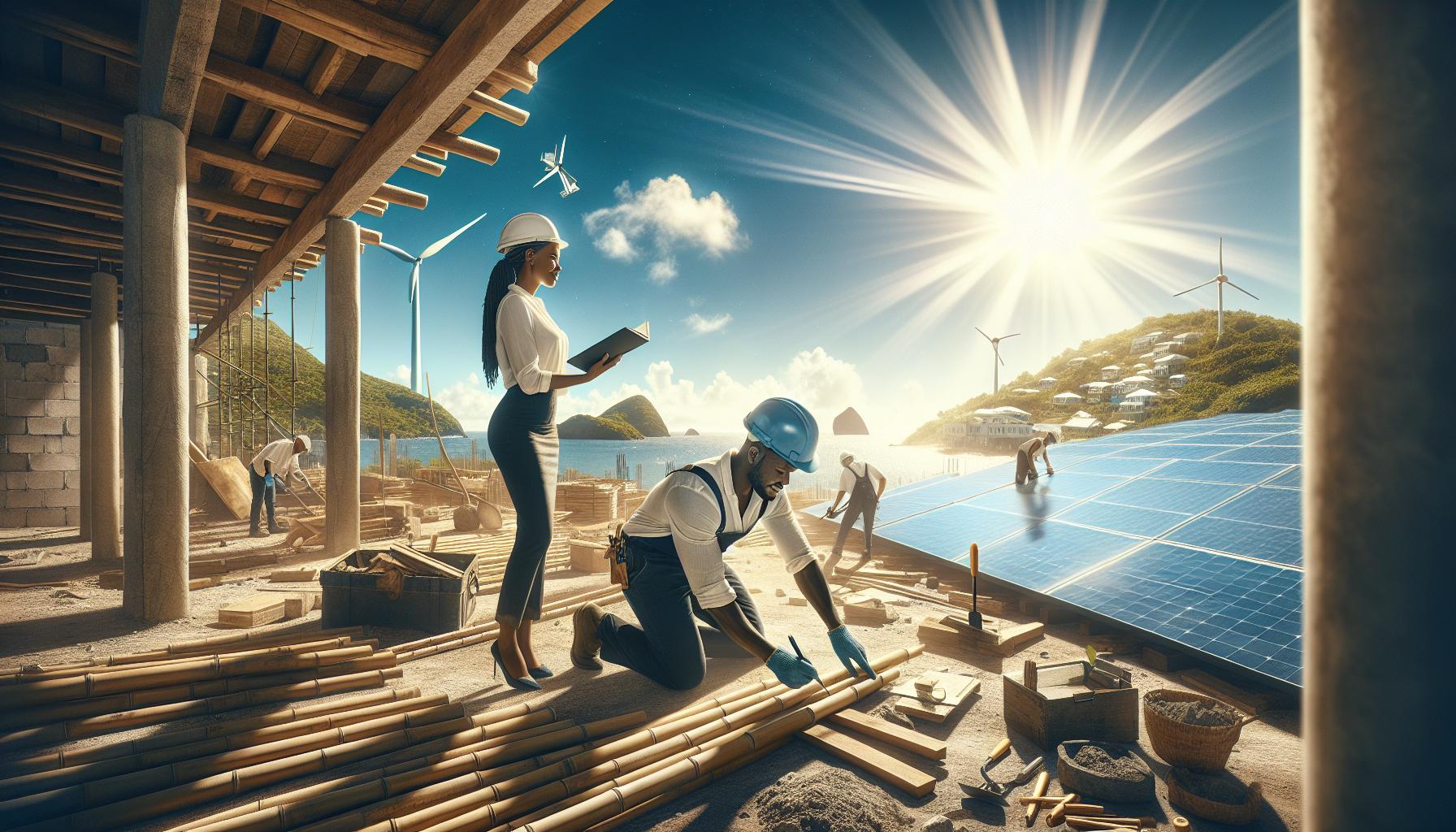
Sustainable construction practices in the Caribbean focus on balancing development needs with environmental preservation. Strategies include renewable energy adoption, green building standards, and using local resources effectively.
Incorporating Renewable Energy Solutions
Integrating renewable energy into building projects boosts sustainability and reduces operational costs. Opt for solar panels and wind turbines, widely applicable in the Caribbean, to mitigate reliance on non-renewable resources. Leveraging the region’s abundant sunlight facilitates the generation of clean energy, optimizing performance and cutting long-term utility expenses. For example, photovoltaic systems are increasingly used for residential and commercial construction in the Caribbean.
Combining energy-efficient technologies like LED lighting, energy management systems, and solar water heaters improves resource usage. Smart grids integrated with renewable systems ensure energy reliability during storms or outages. These installations align with sustainable construction practices, addressing climate change impacts while maintaining cost-efficiency.
Reducing Environmental Impact Through Green Building Standards
Applying green building standards emphasizes resource preservation and ecological balance. Adopting certifications like LEED or EDGE ensures eco-friendly construction methods. Features like rainwater harvesting systems, energy-efficient HVAC systems, and sustainable site planning reduce negative environmental effects. Such implementations address construction challenges unique to the Caribbean, such as frequent storms and high humidity.
Maximizing waste reduction through recycling materials and minimizing on-site emissions supports sustainability. Using environmentally safe finishes and paints, for instance, lowers indoor air pollution. Compliance with green standards aligns projects with both environmental priorities and regulatory requirements, ensuring resilient and responsible building practices.
Leveraging Local Materials and Labor for Sustainable Development
Using locally sourced materials strengthens regional economies and minimizes environmental impact. Choose resources like bamboo, limestone, and indigenous woods, which adapt well to tropical climates and reduce transportation emissions. This approach helps address construction challenges by ensuring materials are readily available and climate-suited.
Employing skilled local labor supports sustainable development and ensures cultural relevance in design. Local artisans and engineers bring valuable insight into traditional Caribbean construction techniques, enhancing project efficiency. Collaboration with regional suppliers fosters economic resilience, tackling disparities caused by fluctuating construction demand. This strategy aligns with sustainable construction practices, prioritizing community involvement and environmental stewardship in building in the Caribbean.
Solutions to Common Construction Challenges
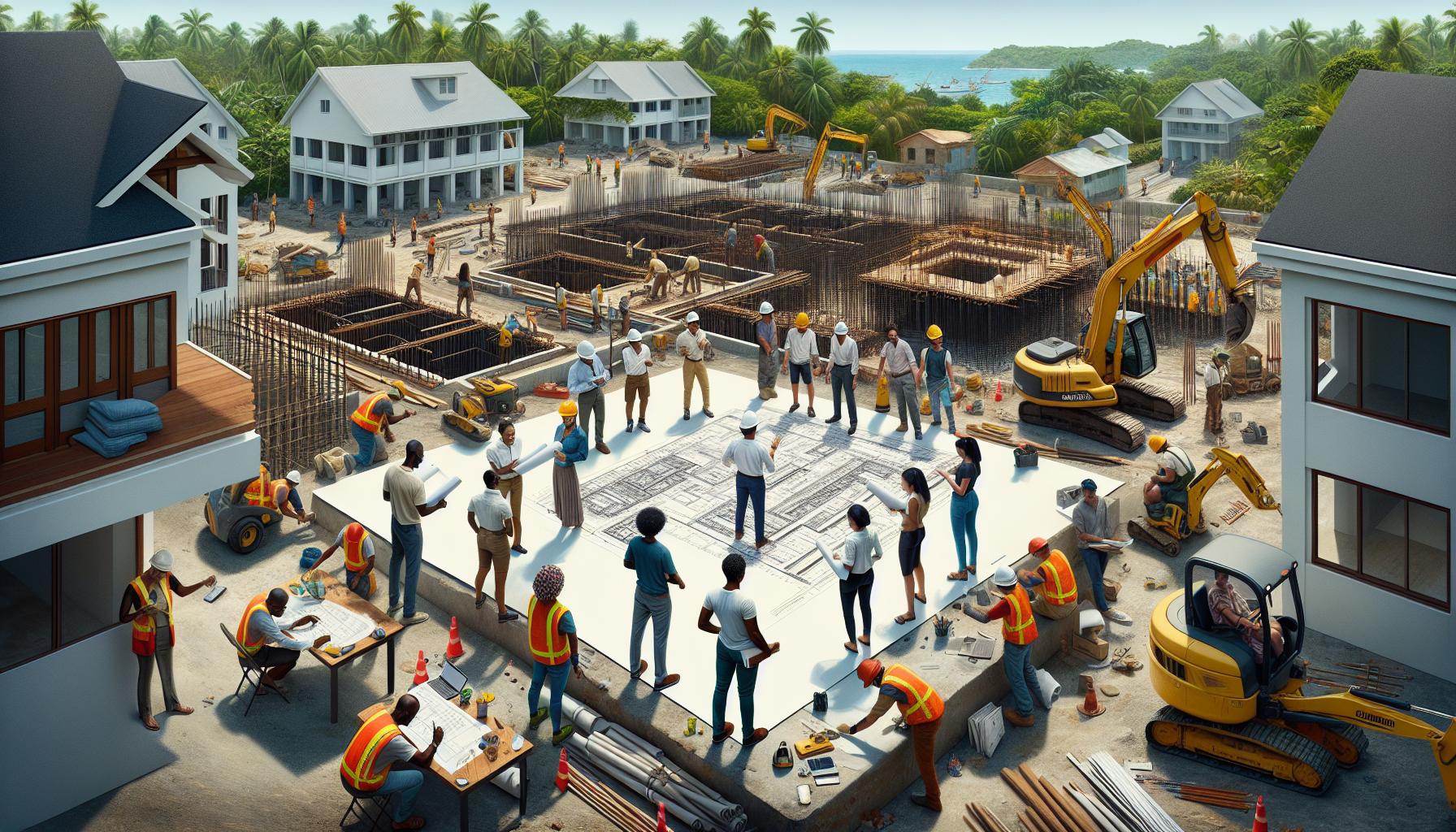
Addressing construction challenges in the Caribbean requires targeted approaches to ensure resilience and sustainability. Factors like material shortages, local expertise, and project constraints must be managed effectively.
Overcoming Supply Chain Issues and Material Shortages
Supply chain disruptions and material shortages often impact construction in the Caribbean. Remote island locations and reliance on imports can cause delays and drive costs higher. To minimize such challenges, focus on building robust supplier networks and sourcing locally produced materials where possible. Collaborating with regional manufacturers for products like cement, aggregate, and environmentally friendly timbers can counter import dependency.
Use advance procurement planning to secure critical materials ahead of seasonal demand spikes. Prefabrication can also reduce material waste and dependency on external suppliers by manufacturing components off-site. Storing surplus inventory for high-demand items mitigates risks of supply disruptions caused by logistical delays or extreme weather events. These steps enable smoother project timelines and cost stabilization.
Building Partnerships with Local Experts and Stakeholders
Strong partnerships with local experts strengthen construction projects in the Caribbean. Engage architects, contractors, and engineers familiar with regional conditions to design resilient, climate-adaptive structures. Collaborating with stakeholders ensures compliance with local codes and cultural alignment in building designs.
Involve municipal governments, regulatory agencies, and community leaders early to streamline permitting processes and address zoning challenges. Establishing relationships with local workers and labor unions is essential for maintaining workforce stability and avoiding project delays. Trusting local expertise also supports sustainable construction practices by prioritizing environmentally sensitive solutions and leveraging traditional construction methods.
Strategies for Managing Costs and Timelines
Managing costs and timelines is crucial for reducing the impact of construction challenges in the Caribbean. Use digital tools like Building Information Modeling (BIM) to optimize resource allocation and identify project inefficiencies. Prefabricated or modular construction methods save time while ensuring quality control in tropical environments.
Forecast weather patterns to schedule work around high-risk storms and avoid delays. Source materials locally, when feasible, to lower transportation expenses and benefit regional economies. Effective contract management with transparent milestone tracking creates accountability and keeps projects within projected budgets and timelines. These strategies help balance efficiency with long-term sustainability.
Conclusion
Caribbean construction demands a thoughtful approach that balances resilience, sustainability, and cultural integrity. By embracing innovative technologies, sustainable practices, and local expertise, you can overcome challenges like climate risks and regulatory complexities while creating structures that stand the test of time. Collaboration, proactive planning, and a commitment to environmental stewardship are key to shaping a future where the region’s unique beauty and heritage are preserved through smart, durable, and efficient construction practices.